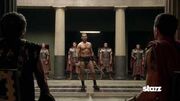
The patronage system (patrocinium) was a key mechanism of Roman political, economic, and social function. In the series, patronage is an important factor in much of the plot of the first two seasons. The most prominent patronage relationship is that between Quintus Lentulus Batiatus and Gaius Claudius Glaber or Marcus Licinius Crassus. Only the former came to fruition, and Glaber's new control over the ludus contributed to the uprising at the house of Batiatus.
The Roman patronage system was highly complex, and remains a topic of heated scholarly debate to this day. More than a working relationship or an economic system, the roots of patronage come from Rome's origins, philosophy, and identity. It shaped not just financial and economic affairs, but every aspect of Roman life. Despite (or because) of this, the details of the patronage system and how it functioned are sometimes unclear, or disputed. What follows is an oversimplified description of the components and function of the Roman patronage system, though this is by no means exhaustive.
Overview
The general summation of Roman patronage is that a wealthy patron would provide funds or support to a client, who used those resources to create a product and/or perform a service. The patron may receive a portion of the profits of the client's enterprise, but their main benefit would have been social and political leverage.
In return, the patron would claim to protect the clients' interests in the political sphere, provide them with legal representation, grant them land, dole out cash, or simply provide food. This relationship would--at least in theory--compensate for the inaccessible central government by fulfilling the physical and social welfare needs of the lower classes. In reality, patrons would often not keep their poorest clients supplied with the things they needed, leading to increased hunger, crime, and social unrest.
Origins and Ideology
Roman authors cite Romulus, the legendary founder of Rome, as the creator of the patronage system. Observing stark differences between rich and poor, Romulus decreed that Roman society would function on the reciprocal relationship between a patron and his clients. Romulus believed, as would many Romans after him, that elites were inherently superior to the common people: they organized society, facilitated the allocation of goods and services, and had the technical and theoretical training to understand how to run a state. The common people did not and could not understand the technical, theoretical, and (perhaps most importantly) philosophical concepts needed to make informed decisions about governance[1].
The ignorant masses, like children, did not have the faculties to provide for themselves and their society. Yet their cooperation was still needed in order for the society to function. They needed a small educated class of political and economic leaders who could, like a father, be trusted to make informed decisions on their behalf, to see that they were provided for and the "family" (the society) could function and thrive. So a small group of patres (fathers) was appointed to create laws and then to educate the masses on how to follow them. The families of these men would hold the status of "patrician", to indicate their pre-ordained role in society and their proximity to the founders of Rome[2]. The historicity of a leader named Romulus, as well as his role in the formation of the Roman patronage system, are disputed. However, patronage is a well-documented and highly prevalent theme throughout Roman history.
Components
The composition of the Roman patronage system had two primary facets: patrons and clients. The relationship between these parties was the primary means by which the Roman republic , and this relationship was rooted (at least according to proponents of the system) in the concepts of reciprocity and patrimony. In short, patronage was an interpersonal and societal relationship of exchange, made possible by a culture in which all members of a hierarchal society attempt to be interdependent on each other. But realistically, patronage arose out of a complex network of historical and cultural factors, and it tended to perpetuate severe inequality and social unrest in the long-term rather than create social equilibrium.
Patrons
Patrons (patroni, singular patronus) were almost always from the upper classes of Roman society, namely the Patrician class. Some plebeians could accumulate enough wealth and power to become patrons, but it was relatively rare. Patrons could be individuals, but it often included entire families. The paterfamilias would have the final say over maters related to patronage, and would likely be the one with whom clients would consult. It is believed that a large percentage of an upperclass Roman man's day was devoted to essentially holding court, or having hours at his home or business during which time he would meet with current and potential clients to discuss their affairs.
Patrons, at least in theory, had many duties. They would supply their clients with resources, the contents of which were discussed at the time of the initial agreement, and updated as needed periodically. The resources they provided could include any combination of money, food, land, tools or supplies, legal representation in court, advocating for the clients' interests in government, and education in the laws and policies of the community and the republic.
Clients
Clients (clientes, singular cliens) were usually from the Plebeian class. They could be somewhat wealthy, but often they were from the lower levels of the working class, but not slaves. Once a dominus freed a slave, they would become his client.
Patrons could become clients of their peers, or of those above them in status and wealth, without losing their own clients. This became a problem in the late republic, when wealth was concentrated amongst fewer and fewer patrons of a very small upper class. One individual or family, though they may only have a few clients themselves, would be at least partly responsible for their clients' clients. When the patron at the top of this hierarchy was no longer able or willing to support their clients, their clients and their clients' clients would suffer. If just one inidividual or family moved away or became runed, hundreds or even thousands of households could face shortages of money and food, and even starve. This prompted the Grain Dole of the late republic, which provided grain for the poor regardless of patronage. The Grain Dole was its own form of patronage, except instead of being between private individuals, it was between the Roman state and private individuals. Inherent in the Grain Dole was hope--or assumption--that in exchange for receiving food for survival, the Roman masses would not be drawn to crime, would participate in their domain of the political process, and would contribute to the society. It was intended to prevent starvation, unrest, and social collapse, and was popular among the lower classes. However, this was seen as a political victory for the populist Populares party, which upset the traditional Optimates party and increased political unrest for the remainder of the republic.
Function
Patronage served numerous purposes in Roman society. The most obvious of these was commercial, but interrelated with it were many other objectives, far too expansive to name in their entirety. More generally, it can be said that patronage fulfilled and intertwined the major spheres of life in the Roman republic: economic, political, and social. Clearly these are not independent entities, but this loose categorization of behaviors and relationships will suffice for these purposes.
Economic activity
The patronage system was, in a simplistic sense, a process of investment. It encouraged economic transaction and distributed wealth in a way that was agreeable to all (or most) members of society. Patrons would invest money or other resources into their clients, who would use the patron's contribution to pay the costs of operations and, if possible, expand the business and grow their own wealth. This facilitated the wealthy putting a small portion of their money back into the economy--money that otherwise would have sat idle in personal coffers--without feeling like they were being robbed.
For clients who did not own or operate businesses, the patron would sustain them directly by providing cash or other physical resources. The patron could also help a client receive (or avoid paying) damages in a legal case by serving as or providing legal counsel. A client with a powerful enough patron may have a certain level of exemption from various laws, depending on the wealth and status of the patron. Relatedly, and perhaps most importantly, the patron would be responsible for keeping their clients informed of the laws of the republic. Given the way in which the government of the republic functioned, the common people had no access to the law-making process, or the men making the laws. They could easily be totally ignorant of the law, and unknowingly commit crimes which would hamper the functioning of Roman society. To remedy this, patrons were expected to provide their clients with a bare-minimum understanding of the laws which they were expected to follow.
Political influence
Individuals who were wealthy enough to act as patrons could use their leverage with their clients to build political support, but the reverse was also possible: depending on the prestige of the patron, a client may improve their own social standing through association, and a profitable patronage relationship may generate enough money that the client themselves may use their position to advance politically. However, this dynamic often simply dissolved into orchestrated mob violence.
Social dynamics
Though not slavery in itself, the patronage system rigidified Rome's unequal, servile culture: a culture based on one or a few powerful individuals who then exerted control over the masses, who were accountable to that individual. The ability of patrons to accumulate massive sums of money, slaves and freemen laborers, and real estate shaped the republic throughout its existence, and ultimately was a major contributor to its collapse. Allowing all aspects of society to be reduced to assets in the hands of powerful private citizens led to the collapse of Roman domestic agriculture, and from there to homelessness, disease, and crime in cities, and myriad other social conflicts. These conflicts would culminate in the Roman civil wars, three Servile Wars, the formation of the Triumvirate, and the fall of the republic.
History
As patrons became less accountable to their clients and more powerful in the political realm, key aspects of Rome's society began to disappear from the control of the central government. In particular, the Roman agricultural sector fell largely into the hands of a few patrons, who owned the majority of Roman Italy's farm land and evicted Italic and Roman farmers. These individuals would move to cities, especially to Rome, where there was not enough work, housing, or infrastructure to accommodate them. The resulting disease and chaos paved the way for the Roman civil wars between Gaius Marius and Lucius Cornelius Sulla, which many believe marked the beginning of the end of the republic.
In the show

Patrons in the series:
- Tullius
- Gaius Claudius Glaber
- Marcus Licinius Crassus
- Ilithyia (by way of Glaber)
Clients in the series:
- ↑ Kings and Generals. 2020. “Roman Patronage System.” Video, 11:58. https://www.youtube.com/watch?v=rD7Gux8R2DA&t=14s
- ↑ Pennsylvania State University. 2013. "Roman Patronage in Society, Politics, and Military." https://sites.psu.edu/romanpatronagegroupdcams101/societal-patronage/